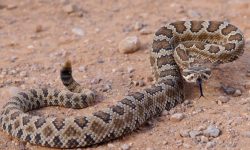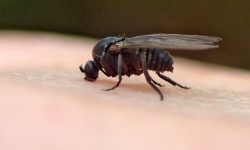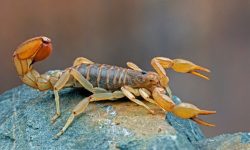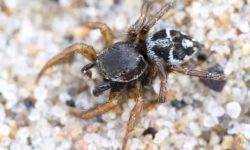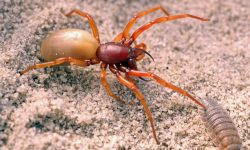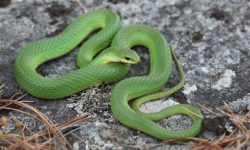Caterpillars are among the scariest creepy crawling creatures in the world. But it always amuses me that these crawling insects turn into beautiful butterflies or moths after a certain period.
Texas is home to several caterpillar species that come in different shapes, colors, and sizes. Most types of Texas caterpillars are horned, stinging, furry, and spiky. These worm-like creatures can also be black, brown, green, and stripped.
Examples of caterpillars in Texas are the black swallowtail caterpillar, cecropia moth caterpillar, Polyphemus caterpillar, eumorpha sphinx caterpillar, and Carolina sphinx moth caterpillar.
Learning to identify Texas caterpillars can help differentiate between harmful and harmless species. The information will also help distinguish between furry species that can cause skin irritation.
We wrote this identification guide to highlight a few types of caterpillars in Texas. The pictures and descriptions will help you identify different kinds of Texas caterpillars. Take the time to read through and identify them.
Are Texas Caterpillars Poisonous?
Texas caterpillars can be venomous or non-venomous. Most Texas moth caterpillars are stinging varieties and can inject venom into humans or other animals to cause skin-level allergies or irritations.
Examples of stinging Texas caterpillars are saddleback caterpillars, hickory tiger moth caterpillars, and Southern flannel moth caterpillars. The symptoms of Texas caterpillar stings are redness, localized pain, itchiness, and blisters.
We recommend seeking immediate medical attention after getting stung by Texas caterpillars. Besides that, avoid handling all caterpillars without protective gear. Get to know that caterpillar stings are no worse than bee stings.
Different Types of Texas Caterpillars
Texas caterpillars can be identified by color, hair, and spikes. Below is a list of different types of caterpillars in Texas:
Black Swallowtail Caterpillar
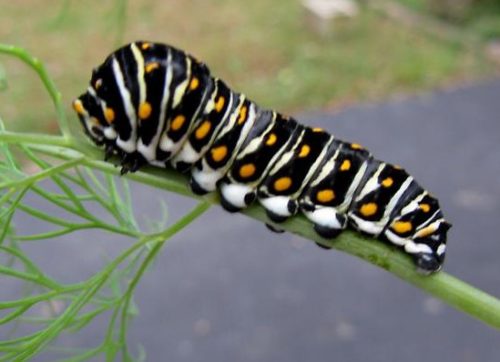
It is a large green caterpillar with black and yellow stripes. The green grub has a fork gland that releases a foul stink to scare potential predators. Juvenile black swallowtail caterpillars are black and white before turning green.
These Texas grubs can grow up to 1.5 inches long in their last instars before undergoing pupation. The green with black and yellow spotted stripes become more conspicuous to display the maturing or end of the larval period.
Black swallowtail caterpillars are poisonous and can kill bird predators when consumed in large quantities. Refrain from handling these caterpillars since the foul stink can cause stomach upset or nausea. (Source: University of Florida).
The green grub will turn into a beautiful black swallowtail butterfly after pupation. The butterflies are often seen in open farmlands and fields from summer through fall. They feature black wings with yellow spots row separated by blue scaling.
| Scientific Name | Papilio polyxenes |
| Host Plants | Mock bishopweed, roughfruits scaleseeds, spotted water hemlock, and water cowbane. |
| Identification Features | |
| What They Turn Into | Black swallowtail butterfly with yellow spots and blue scaling. |
Cecropia Moth Caterpillar
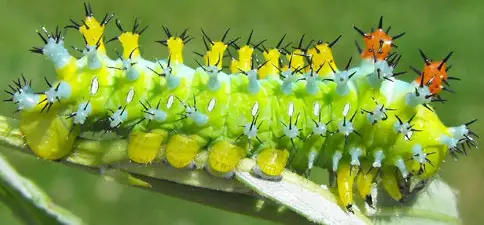
The Texas lime-green caterpillar has a rigged segment with longitudinal rows of blue, orange, and yellow projections. Some species have tiny black spikes on the tubercles though visible under a hand lens.
The cecropia moth caterpillars go through five instars before undergoing pupation. The caterpillars keep changing colors until they approach the final instars. A mature cecropia moth caterpillar measures about 4 inches long.
These unusual lime-green caterpillars are the largest in Texas and are common in North American regions. These caterpillars turn into beautiful silk moths with reddish bodies and black to brown wings separated by white, tan, and red bands.
| Scientific Name | Hyalophora cecropia |
| Host Plants | Birch, cherry, and maple |
| Identification Features | The enormous size and lime-green color with conspicuous segments. |
| What They Turn Into | Beautiful silk moth |
Polyphemus Caterpillar
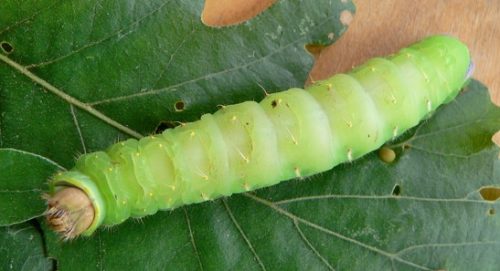
It is a huge bright green silkworm with crimson red dots row and wispy spines on its back. Immature Polyphemus caterpillars are bright yellow and later become bright green with red spots before pupation.
The caterpillar species can grow up to 3-4 inches long with a voracious appetite. They love feeding on leaves of willow, red alder, yellow birch, and oak trees. Research shows that these grubs can eat about 86000 times their weight.
These bright green silkworms turn into beautiful brown moths after pupation with conspicuous eyespots on the hind wings for easy identification and classification. We recommend not handling the caterpillars to avoid stings.
| Scientific Name | Antheraea polyphemus |
| Host Plants | Alder, Oak, Birch, and Poplar |
| Identification Features | Red spiny bumps around the bright green body segment. |
| What They Turn Into | Beautiful brown moth |
Eumorpha Sphinx Caterpillar
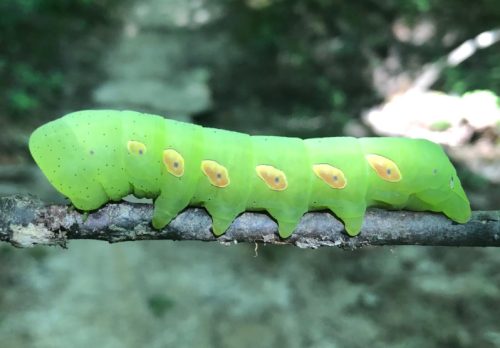
The eumorpha sphinx caterpillars are also known as banded sphinx. The diagonal yellow stripes, spiked tails, and black dots row along its sides are the main identification features of the green grub.
However, the caterpillar keeps changing colors due to development in each instar. It may range from green to multicolored orange, black, yellow, and white. The rear horn becomes a pointed tail in the final instar before pupation.
The caterpillars prefer feeding on evening primrose family plants and turn pink when approaching pupation. They turn into spectacular brown moths with dark pinkish-brown wings.
| Scientific Name | Eumorpha fasciatus |
| Host Plants | Evening primrose, Fuchsia, magnolia, and grape. |
| Identification Features | Green with yellow, black, or orange stripes. |
| What They Turn Into | Brown moths with dark pinkish-brown wings. |
Carolina Sphinx Moth Caterpillar
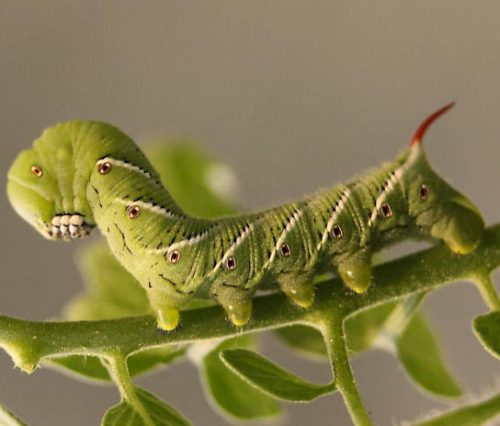
The Carolina sphinx caterpillar is also called the goliath worm or tobacco hornworm. The bright green tube-shaped body with diagonal white stripes and black dots is ideal for easy identification.
The large green grub also has a reddish or black horn at the end. Besides that, this green caterpillar can grow up to 2.7 inches long. The abdominal markings help distinguish this green-striped tobacco hornworm from tomato hornworm.
Tobacco hornworms have a single stripe, while tomato hornworms have V-shaped markings. These caterpillars turn into beautiful hawk moths or Carolina Sphinx moths with dusty brown wings.
| Scientific Name | Manduca sexta |
| Host Plants | Potato, tobacco, and tomato |
| Identification Features | Long tube-shaped green caterpillar with creamy white and black stripes along its sides. |
| What They Turn Into | Hawk moths |
Honey Locust Moth Caterpillar
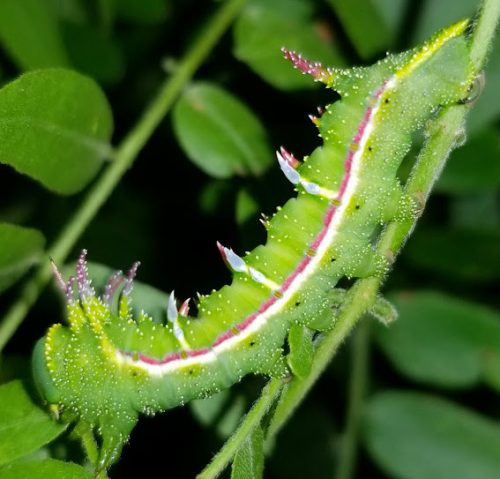
It is a green caterpillar with white and red longitudinal stripes along its sides. The red horns on either end and protrusion on the body segment are other identification features of these grubs.
The honey locust moth caterpillar is also covered with yellow-white spots and can grow up to 1.5 inches long. These caterpillars love to feed on the leaves of honey locusts and Kentucky coffee trees.
| Scientific Name | Syssphinx bicolor |
| Host Plants | Honey locust trees and Kentucky coffee trees. |
| Identification Features | A pair of red horns on its head and a single horn at the tail. |
| What They Turn Into | Gray moth with shades of pink, brown, and orange. |
Cabbage White Caterpillar
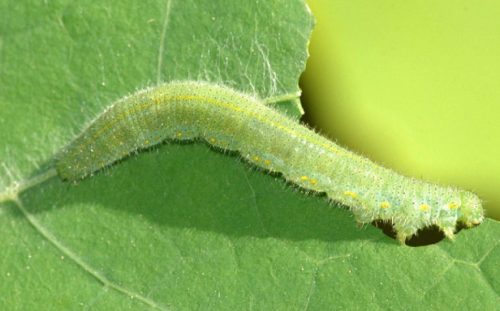
It is a slender pale-green caterpillar with tiny black pits around its body. The grub also has yellow spots around the abdomen, yellow stripes on its back, and fine hairs to ward off predators.
Cabbage white caterpillars change their appearance in each instar. A juvenile caterpillar changes its head from black to pale green. These caterpillars have a voracious appetite and feed on kale, cabbages, mustards, and broccoli leaves.
These caterpillars turn into white butterflies after pupation. These butterflies are common from summer through fall in the open fields and river banks. We recommend using chemical treatments to eliminate the caterpillars from your crops.
| Scientific Name | Pieris rapae |
| Host Plants | Kales, cabbages, and broccoli leaves |
| Identification Features | Slender green body with yellow spots and stripes. |
| What They Turn Into | White butterfly |
Long-Tailed Skipper Caterpillar
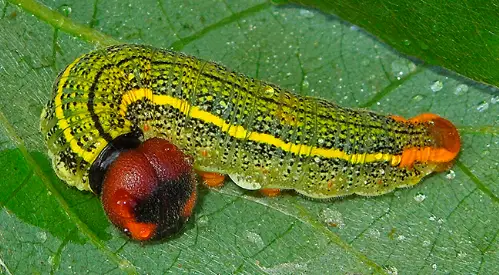
It is a green butterfly larva with a long cylindrical body and round black head. The yellow stripes along the abdomen and orange blotches on the tail are ideal for easy identification.
You can also use the spotted yellow patterns and swollen coffee bean head to identify long-tailed skipper caterpillars in your garden. These green grubs love feeding on wisteria, beans, peas, and hog peanuts.
Also called bean leafrollers since they infest beans, we recommend using pesticides to eliminate them from crops and other ornamental plants. Avoid handling these caterpillars since the fine hairs can cause skin irritation.
| Scientific Name | Urbanus proteus |
| Host Plants | Hog peanuts, beans, blue peas, and wisteria |
| Identification Features | Large round head with longitudinal yellow stripes spotted patterns and orange tail end. |
| What They Turn Into | Vibrant butterfly with a dark blackish brown upper side and iridescent blue-green wing bases. |
Northern Pearly-Eye Caterpillar
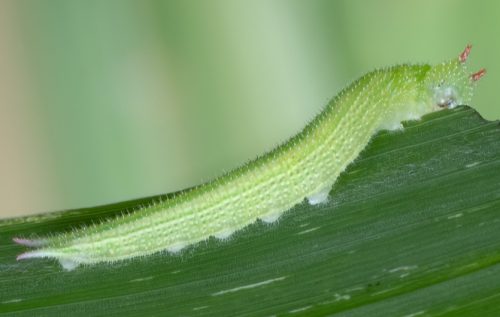
It is a pale-green butterfly grub covered in short hairs and rows of neon-like dots around its body. The pale-pink or reddish horns on the head are distinctive features for easy recognition and identification.
A mature Northern pearly-eye caterpillar is about 1.77 inches long. Besides that, these green butterfly larvae love feeding on sedge plants and various types of grasses in Texas.
These caterpillars turn into beautiful grayish-brown butterflies that hail from North America. The caterpillars are harmless to humans though consumption of large quantities can be toxic to small birds.
| Scientific Name | Enodia anthedon |
| Host Plants | White grass, bottlebrush grass, and river oats. |
| Identification Features | Pale green body with two short orangey, pink, or reddish horns on its head. |
| What They Turn Into | Pearly-eye butterfly with shades of plain brown |
White-lined Sphinx Caterpillar
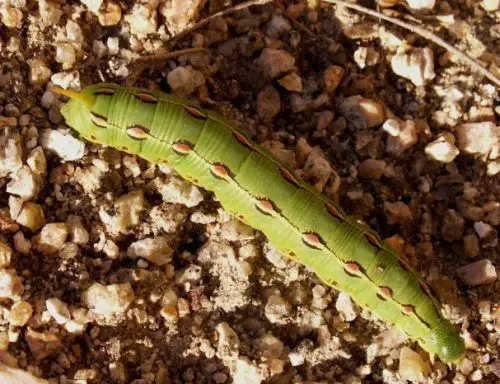
It is a green caterpillar with a cylindrical-shaped body. The black and white abdominal markings, orange legs, and black or orange horns are distinctive features for easy identification.
The lime-green caterpillar keeps changing color in each instar to signify growth and development. When the caterpillar approaches pupation, the color will change to dark green with conspicuous black and yellow spots.
These green caterpillars can defoliate the crops and ornamental plants in your home or garden. They are long and slender with a voracious appetite. Besides that, they are hairless and non-venomous.
| Scientific Name | Hyles lineata |
| Host Plants | Apple trees, evening primrose, and fuchsia |
| Identification Features | Lime-green body with yellow, orange, and black spots. |
| What They Turn Into | Stout-bodied moth with a furry brown body. |
Pipevine Swallowtail Caterpillar
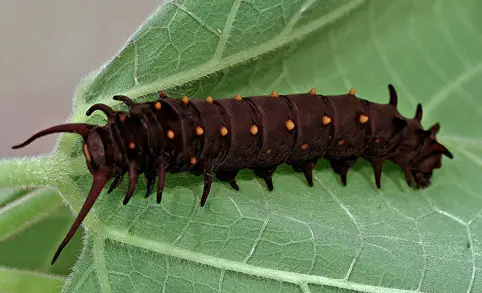
It is a black caterpillar in Texas with fleshy dark brown spines and rows of bright orange spots. The velvety appearance and fine hairs are distinctive features ideal for identifying the grubs.
The caterpillar’s head has two tubercles those look-like horns. Besides that, this grub can grow up to 2 inches long with black dominant color that changes to bright warm red in warm weather conditions.
Pipevine swallowtail caterpillars feed on the leaves of birthworts and Dutchman pipes. They later turn into large butterflies with fairly short hindwing tails. The butterfly’s back is black with striking blue on the hindwings.
| Scientific Name | Battus philenor |
| Host Plants | Birthworts and Dutchman pipes |
| Identification Features | Dark-brown or black body with bright orange spots and fleshy tubercles. |
| What They Turn Into | Large butterflies with black backs and vibrant blue hindwings. |
Texas Southern Flannel Moth Caterpillar
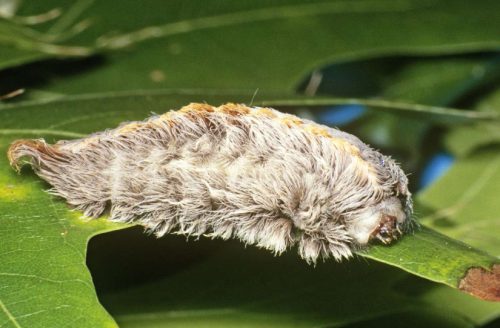
These caterpillars are also called puss moths or asp caterpillars. These teardrop-shaped grubs have soft and fine golden brown hairs with hidden venomous spines. The southern flannel moth caterpillar can grow up to 1-1.5 inches long.
The nasty sting from these grubs can cause severe throbbing pain, swellings, and redness on your skin. Refrain from handling the caterpillar species without wearing protective gear.
Severe sting may require immediate medical attention since no home remedy is effective to alleviate the effect. Texas southern flannel moth caterpillars turn into golden yellow moths after pupation.
| Scientific Name | Megalopyge opercularis |
| Host Plants | Apple, almond, hackberry, oaks, orange, pecan, and roses. |
| Identification Features | Softy furry hairs and teardrop shape |
| What They Turn Into | Golden yellow moth with grades paler beige at the rear. |
Saddleback Caterpillar
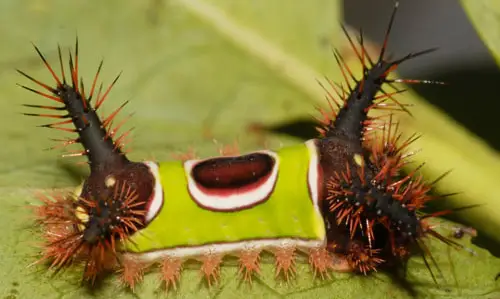
It is a stinging caterpillar with four protruding fleshy spines at each corner and small stinging organs around the sides. The brown caterpillar also has a green saddle blanket on the back for easy identification.
These caterpillars can grow up to 0.78 inches and the sting causes severe skin burning and inflammation. When the venom-filled spikes are lodged into the skin, it results in intense itchy rashes.
These unusual green caterpillars feed on corn, asters, apples, blueberries, citrus, dogwood, elms, and grapes. Use chemical treatment to eliminate these caterpillars from your backyard trees and shrubs.
| Scientific Name | Acharia stimulea |
| Host Plants | Apple, asters, blueberries, citrus, corn, dogwood, elms, and grapes. |
| Identification Features | Bright green saddle with a brown patch and protruding brown spiky spines. |
| What They Turn Into | Grayish brown moth |
Peacock Moth Caterpillar
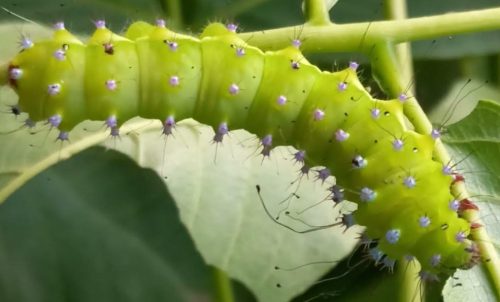
The peacock moth caterpillar is also known as the lo moth caterpillar. The spiky green caterpillar has urticating hairs filled with venom. Avoid handling this bright green grub with red and white stripes along its sides.
The fuzzy green caterpillar can grow up to 2.3 inches long and the spikes can cause a burning sensation and skin swellings. No home remedy can effectively reduce pain and swelling.
The peacock moth caterpillars can defoliate the plum, apple, blackthorn, ash, walnut, and poplar trees. These caterpillars turn into brown, yellow, or grey moths with distinctive spots on the wings’ ridges.
| Scientific Name | Automeris io |
| Host Plants | Apple, poplar, blackthorn, ash, and walnut trees |
| Identification Features | Red and white stripes along the abdomen |
| What They Turn Into | Grey, yellow, or brown moths |
Hickory Tiger Moth Caterpillar
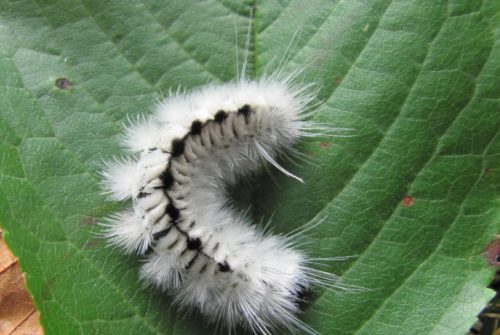
It is a white fuzzy caterpillar with black markings on the back. The hickory tiger moth caterpillar also has a tuft of white and black hair. Other identification features are a rounded black head and tufts of black pencil hair.
The hairy white and black grub can grow up to 1.77 inches long. The urticating hairs do not contain venom though they can cause skin irritation and rashes. Exercise precautions when walking in parks or forests infested with tiger moth caterpillars.
These moth caterpillars feed on birches, quaking aspens, basswood, and black locust plants. They turn into hairy pale-brown moths with white hindwings and yellowish-brown forewings after pupation.
| Scientific Name | Lophocampa caryae |
| Host Plants | Birches, quaking aspens, basswood, and black locust. |
| Identification Features | Cream-white body and black markings |
| What They Turn Into | Hairy pale brown moth |
Banded Woolly Bear
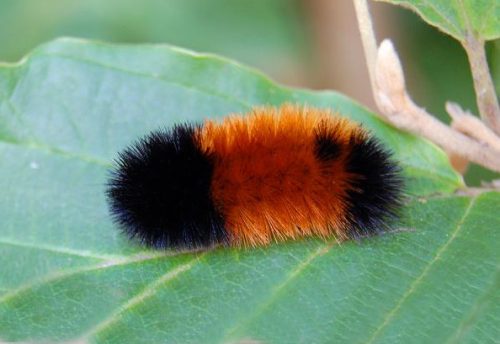
It is a type of furry black and orange caterpillar native to Texas. The black fuzzy caterpillar has a unique broad orange band around its body. The grub becomes less black and more reddish-orange when it approaches the last instars.
The hairy caterpillar can grow up to 2 inches long and does not irritate or sting. But the hairs are sharp with a cuddy appearance. Refrain from handling these caterpillars without wearing protective gear.
The banded woolly bear caterpillars love rolling into a ball when under threat. These caterpillars turn into spectacular moths with orangish-yellow appearance and are common in Southern Canada.
| Scientific Name | Pyrrharctia isabella |
| Host Plants | Clovers, birches, corns, elms, maples, and sunflowers |
| Identification Features | Broad orange and black band around its body |
| What They Turn Into | Orangish-yellow moth |
Salt Marsh Caterpillar
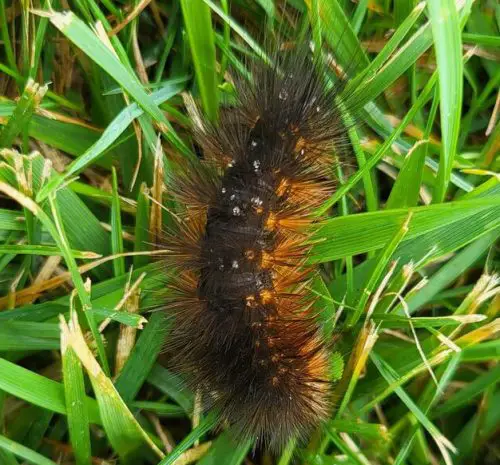
It is a slender caterpillar with a black-brown body and orange-red or black hair. The fine wispy hairs cover each segment with a row of black or orange warts and white spots. It can grow up to 2 inches long in summer, spring, and fall.
The furry grub also comes in various colors though rusty brown and dark brownish are common in Texas. These hairy caterpillars love feeding on apple tree foliage, cabbages, and pea, potato, and cotton plants.
Keep away from these Texas caterpillars since the hairs can sting and cause severe skin irritation. The caterpillar turns into a beautiful orangish-yellow butterfly with a white head and thorax.
| Scientific Name | Estigmene acrea |
| Host Plants | Apple trees, cabbage, tobacco, potato, clovers, cotton, and corn. |
| Identification Features | Brownish-orange caterpillar with black or orange spots around the body. |
| What They Turn Into | Orangish-yellow butterfly with white head and thorax. |
Bordered Patch Caterpillar
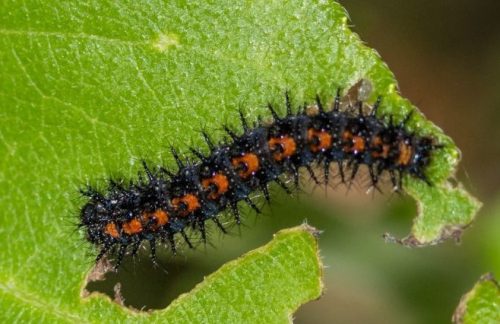
It is a beautiful butterfly caterpillar with short black spikes around each segment. You can also identify these grubs by their dark-chocolate brown patches and row of branched spikes along their sides.
These white Texas caterpillars feed on blueweed, ragweed, Jerusalem artichoke, and sunflowers. Some scientists also call them sunflower patch caterpillars due to their association with the plants.
The long spikes contain hollows for transmitting venom from the toxic glands. Be cautious when walking in sunflower plantations infested with bordered patch caterpillars to avoid skin irritation.
| Scientific Name | Chlosyne lacinia |
| Host Plants | Blueweed, sunflower, ragweed, and Jerusalem artichoke |
| Identification Features | Dark chocolate brown patches with short black pikes around its body. |
| What They Turn Into | Black and brown butterfly with orange bands and white spots. |
Mourning Cloak Caterpillar
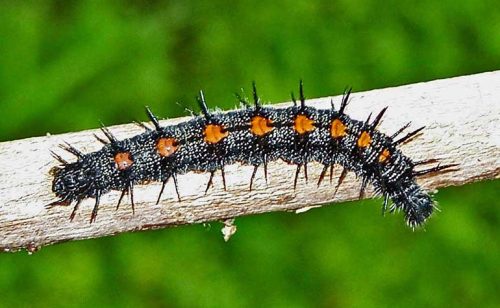
It is a spiky caterpillar type with tiny white spots and deep reddish-orange blotches along its back. The mourning cloak caterpillars also have small white setae on their back to ward off potential predators.
These white grubs can grow up to 2 inches long and maintain their slender bodies despite their voracious appetite. These caterpillars feed on the leaves of willow, elm, birch, and hawthorn plants.
Mourning cloak caterpillars also love living in silk nests on the host plants. Be sure to refrain from handling these caterpillars since the spiny spikes can sting and cause skin-level allergies.
| Scientific Name | Nymphalis antiopa |
| Host Plants | Willow, birch, rose, mulberry, and elm |
| Identification Features | White-spotted caterpillar with protruding black spiny spikes. |
| What They Turn Into | Dark maroon butterfly with cream bands |
Zebra Longwing Caterpillar
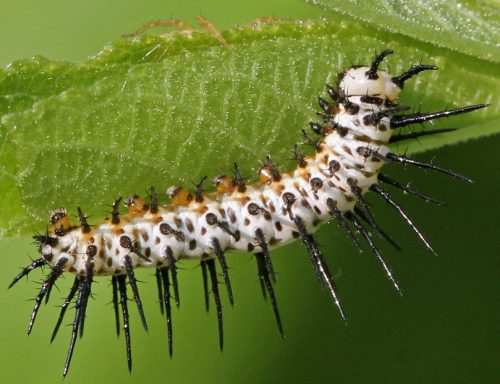
It is a worm-like caterpillar with creamy-white plump and huge spiny spikes around its body. The black spots that turn deep red on the back as the grub approaches the final instars are the distinctive features.
These grayish-white grubs with black tube-like bodies measure 0.5 inches long. We recommend not touching these caterpillars since the spiny spikes can sting. Besides that, the spikes cause skin-level allergy due to venom.
Zebra-longwing caterpillars love feeding on foliage from plants that belong to the Passiflora genus. The venom in the caterpillars can be toxic to small birds if consumed in large quantities.
| Scientific Name | Heliconius charithonia |
| Host Plants | Purple passionflower and passiflora incarnate. |
| Identification Features | White and black caterpillar covered in long spiny spikes. |
| What They Turn Into | Beautiful butterfly with white and black stripes on the wings. |
Final Thoughts from Experts
The State of Texas has over 134 caterpillar species with unique shapes and colors. These caterpillars are in the larval stage of moths or butterflies with some species being harmful and harmless to humans.
Most moth caterpillars in Texas have spikes that sting to cause skin irritation among humans and animals. But the butterfly counterparts have smooth bodies that pose no dangers to humans. (Source: Maine Department of Agriculture).
How to get rid of caterpillars in Texas is a no-brainer due to many pest control companies. We recommend seeking assistance from these companies though it can be expensive and the chemicals used might reduce soil fertility.
We hope this Texas caterpillar identification guide will help differentiate between harmful and harmless species. Feel free to share your views or experiences with us through the contact page.
People Who Read This Also Read:

